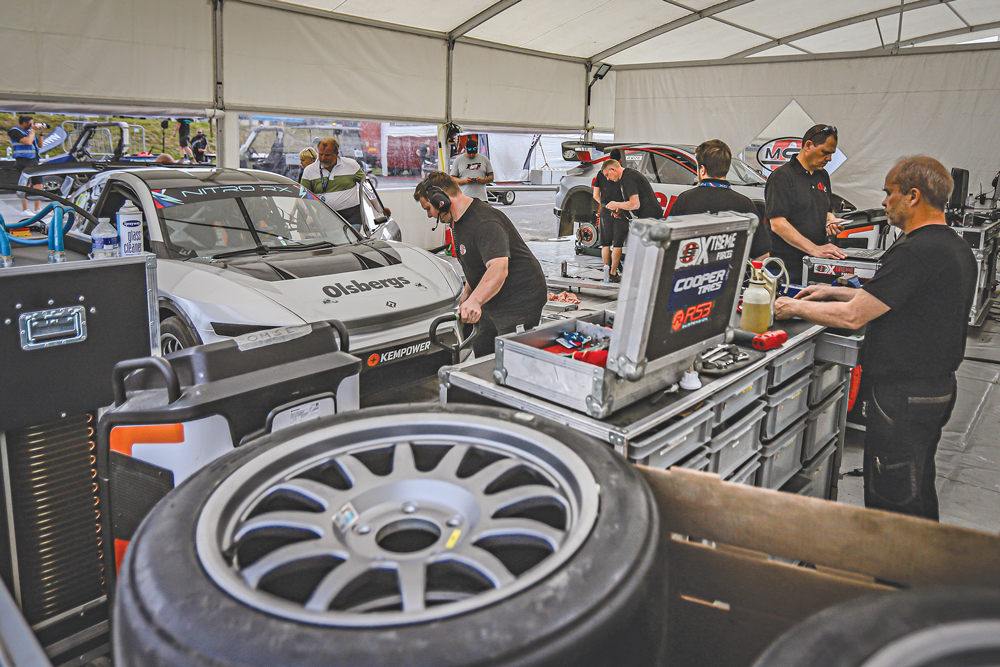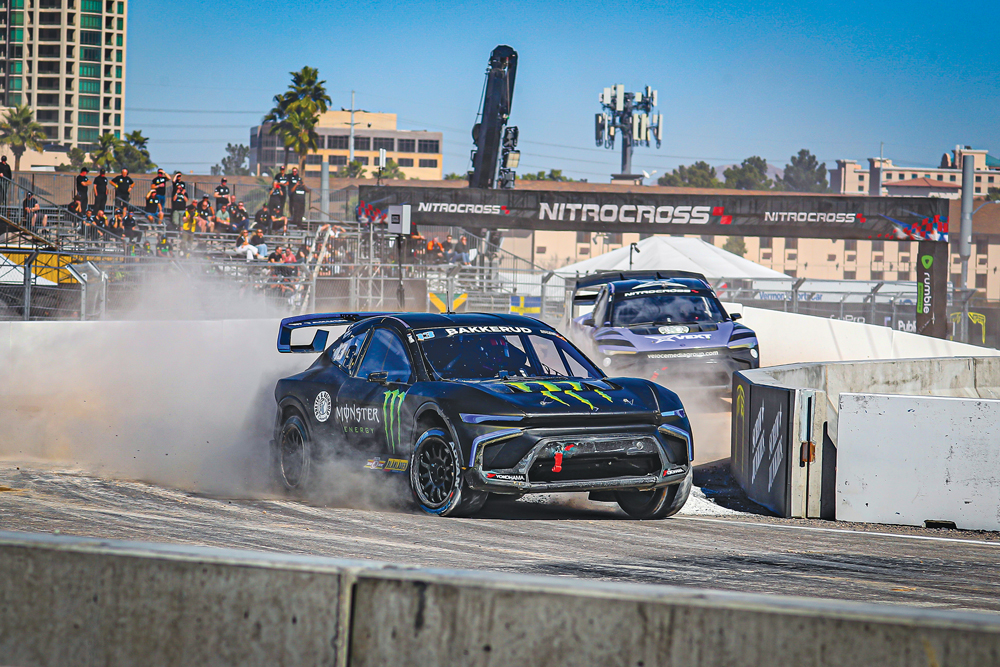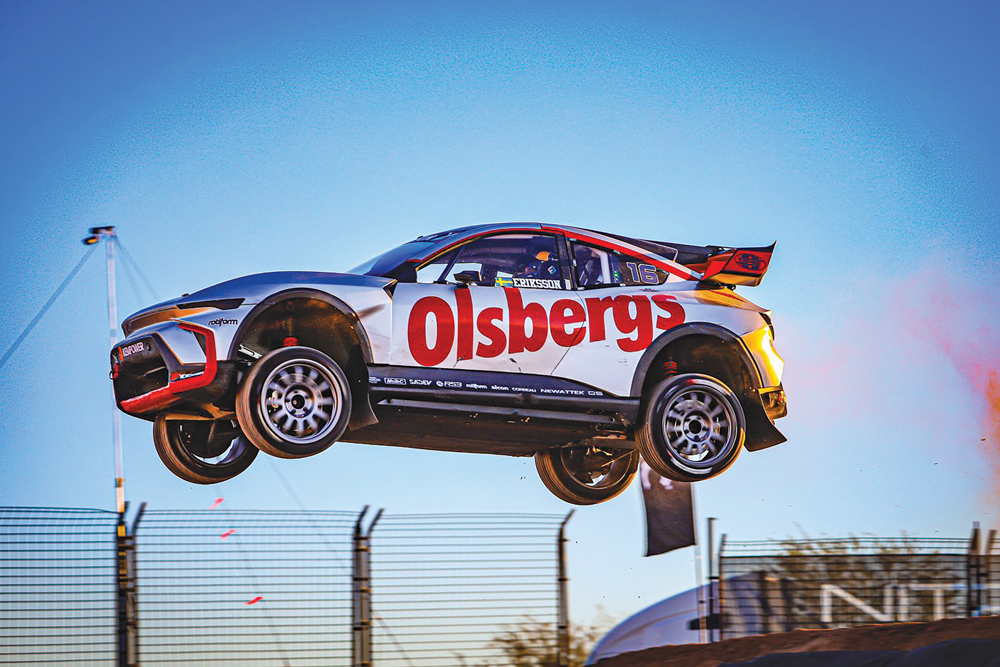Business Profile: Olsbergs Motor Sport Evolution

This Swedish-based company has set out to make electric car racing not only fast and exciting but relevant.
Unless they’re into rallying or its short-course offshoot rallycross, American racing fans may not be familiar with Olsbergs Motor Sport Evolution (OMSE) or the Swedish-based company’s CEO, Andreas Eriksson. Say the names Travis Pastrana, though, or Nitrocross (or Nitro Rallycross, as it was formerly known), and you’re more likely to get an enthusiastic reaction about the entrepreneurial multi-discipline racer/promoter and his latest closed-course racing endeavor, in which four-wheeled machines in various classes drift through corners and leap over jumps on tracks made up of a variety of surfaces. That each heat in each race is covered by a squadron of drones, putting viewers right next to the sliding, flying competitors, only adds to its appeal.
The fastest cars in Nitrocross are those in Group E—that’s E for electric—with motors at both ends of the car driving all four wheels. “It’s basically the equivalent of a 1,000-horsepower car,” said team owner Dennis Reinbold. That’s 1,000 hp in a car that tips the scales just below 3,000 pounds.
“It’s ridiculously fast, scary fast,” Reinbold said. He should know. Dreyer & Reinbold Racing (DRR) fields three Group E cars in the Nitrocross series, and driver Robin Larsson has been the class champion two seasons in a row.
That “scary fast” car, the FC1-X, was developed and built by Eriksson and OMSE. He started working on the project during his COVID-19 downtime, but its roots go much further back. Eriksson was a successful rally driver in the 1990s and early 2000s who applied his skills to rallycross starting in 2005. That was the same year he founded Motor Sport Evolution to build rallycross cars, and in 2009 he formed a partnership with hydraulic company Olsbergs.
His connections with Ford of Europe in the rallycross arena led him to his first trip to America in 2009, when he prepared a Ford Fiesta for driver Marcus Grönholm to race on Pikes Peak. “I saw a completely different world than I was used to,” he recalled, a world that included meeting extreme sports competitors like Tanner Foust, Ken Block, Brian Deegan, and Pastrana. Eriksson helped introduce rallycross to the US and was instrumental in Pastrana’s formation of Nitro Rallycross.
More Performance, Less Consumption
Yet in addition to his promotional efforts behind rallycross, Eriksson had another agenda, what he describes as “more performance for less consumption.” Back when his company built Ford Fiestas for rallycross, “we were making small motors with high performance,” turbocharged EcoBoost engines “that were faster and better than conventional motors but with half the fuel consumption.” He has “always,” he said, “been against the use of fossils in our nature, trying to go from fossil use to fossil free.
“I don’t think we should pump things out of the earth,” he said. “Maybe for you and me and our children it won’t be a problem, but for generations to come, if we are growing the fossil use, we will create the problem.”
That reasoning led to work with ethanol fuels and, six years ago, his partnership with German fuel formulator P1 to develop a biofuel that was “more powerful but also 100% fossil free. We’ve been running that in the RallyX Nordic series in Europe.”

COVID gave Eriksson the time to contemplate the next step in his fossil-free evolution. “We need to make faster cars,” he realized, “and how do we make faster cars cheaper? The turbo cars were one way of going forward, but how can we make a performance car and a rallycross car faster than everything else? That’s when I started to look into electrical.”
Eriksson recognized that he couldn’t make a car that was “equal to the other cars. We can’t make a Supercar that’s exactly the same as the other Supercars, make it equally fast and just take the sound away. No one would like that. I wouldn’t like that.” No, this car had to be something “over the top. It needs to jump farther and be the fastest car anyone has ever driven.” But at the same time, he felt it needed to be “built like normal electric cars will be built in the future, to be relevant.”
Relevance is an important concept to Eriksson. The word “relevant” came up 22 times during our hour-long conversation. He wants relevance to the drivers, to attract top talent to the cars, but also relevance to the auto manufacturers, and by extension to the people who buy and will buy electric cars from them.
“We had a lot of manufacturer meetings asking them, ‘If we do this, which way would you prefer we go? How will electrical marketing be for you in the future, and what cars will be your priority?’ Our idea, obviously, is ‘Race on Sunday, sell on Monday.’ So we made a platform that they could put their own body on, and we could guarantee that it was performing, that it was safe, and that it was a very, very fast machine that people would love to see.”
Built from Scratch
The FC1 was “100% built from scratch,” Eriksson said, starting with a space-frame chassis and long-travel double-wishbone suspension. The carbon-fiber body is an original design, purposely mimicking the style of today’s small CUVs and hatchbacks. This was done to provide standardized pick-up points that manufacturers could use when dropping their own body shell over the chassis.
Power for the FC1 can be provided by motors in the rear to power the rear wheels, or motors front and rear for all-wheel drive. The FC1-X variant exclusive to Nitrocross has four Magelec motors, two at each end, generating more than 1,000 hp and 800 lb.-ft. of torque. The driveline is not computer controlled; Eriksson preferred mechanical differentials connected via a prop shaft and driven by a three-speed transmission. “My background is mechanical engineering,” he explained, “and mechanical grip is what we’re looking for.”
The flat lithium-ion batteries used in the cars “are the same ones the US Army uses in its drones,” Eriksson said. “And we have a different way of cooling them.” OMSE uses cooling fluids “that are impossible to ignite. We make the batteries, I would say, overly safe, because we need to prove to every manufacturer that wants to put their name on a car that they won’t have an issue.” Every FC1-X crash in competition is documented, including their G loads. “I had one crash that was almost 40 Gs,” he said. “We document everything afterwards to meet our guarantee. It’s a costly way to test things, but that’s the only way.”
The initial batch of FC1s was built at OMSE’s facility in Sweden, but the company opened FirstCorner in Salisbury, North Carolina, to serve as a “technical hub” for the electric race cars in the US, Eriksson said. “We sell the cars, we sell the parts, but most of all we do the service.” Everyone working on the FC1s, including race team members, receives specific safety training regarding the car’s electrical and charging systems.

The shop is located in NASCAR country to take advantage of the skilled workforce in the area and because Eriksson has “a lot of friends in NASCAR.” FirstCorner currently has three full-time employees, plus staff on loan from OMSE’s Swedish headquarters as needed, but Eriksson plans to expand the facility—including the addition of a test track—and intends to triple the number of employees within two years.
The eventual plan is for Nitrocross to be “global with an American base,” Eriksson said. He wants it based in the US; all the cars are being made here now, and he has required all component suppliers to have an American presence. “We have the same rule based on NASCAR. You can be a supplier from Europe, but you need to have a representative here in America.” Taking Nitrocross global would be a boon to the automakers involved in the series. “One sport, one world. That’s what we’re aiming for.”
As of this writing, though, no OE manufacturer has signed on. “The car has been approved by manufacturers in the last two years,” Eriksson said. “They’re good. The car fulfills their needs. But we didn’t only have to build the car, we had to build the series as well. When Travis and those guys approached me, I told them I could build a car, but they had to build a series that has all the ingredients as well. The car will not do it by itself. It needs to be a package.”
In fact, he said, “we didn’t want the manufacturers to come too early. We wanted to prove that the car was doing what it was supposed to do, and prove the series was doing what they were supposed to do.” He acknowledged, too, some of the automakers “haven’t got their stuff going yet” when it comes to making and selling EVs, and in the US there remain “challenges” when it comes to electric vehicle infrastructure.
Still, “what we’re doing is relevant,” he said, “because we can help grow the awareness of electric cars, and how fast and cool they can be. At the same time, we can help build a network and understanding about electric car safety. With two seasons under our belt, we have proven the car is extremely safe. We have proven the car is fast, and that it’s something people want to drive. As of today, we’ve built 21 cars, and the cap is 24. So I think we are on a very good path going forward.”
Out of the Park
“I like the FC1 for its relevance to the auto industry, being fully electric,” said Reinbold, an Indianapolis, Indiana-area multi-marque car dealer. “I think we all collectively sold cars to the early adopters in electric, and now [sales are] in kind of a lull.” That will change, he said, when people see that “the performance, and the cool factor, of electric cars is really there. That’s what makes this series so relevant because it highlights that.
“And the car is actually an amazing race car,” he added. “It’s super-fast and very capable of all kinds of driving. It handles really well. It’s an easy product to work on. So they’ve really hit it out of the park with that car.”
Reinbold’s DRR team has fielded entries in a number of race series, notably IndyCar since 2000. He first worked with Eriksson in 2013, when he leased and then bought several Supercar Lites from OMSE to compete in rallycross. He said OMSE and FirstCorner are “very good to work with. On-track they’re there with parts supply and do a very good job of that. They provide technical help as well to make sure everybody’s driving the best, safest race car they can put out there.”
Reinbold recalled one race, in Minnesota two years ago, where two of his drivers rolled their cars. “One we worked on all night and got fixed, and his guys were there to support us. The other one was pretty much unfixable, but [Eriksson] had a replacement car, so we were able to do a one-off lease so we could continue to participate.
“It’s one of those deals that happens in racing,” he noted. “You help your competitors up until the green flag flies, then it’s every man for himself.” (Eriksson’s sons, Kevin and Oliver, are Nitrocross racers as well.) “But in the meantime, you’re all in it together trying to promote the sport and make the sport grow and get better. Andreas has a very good feel for that.”
In the off-season, DRR has attended “a lot of different meetings with FirstCorner in terms of technical updates on the car, and we go back and forth with ideas to make the car better. There’s both technical training and safety training that’s ongoing, and it’s very mutually beneficial.”
Reinbold said DRR has “a few extra cars that we bought that are available for lease. We need good quality teams to be able to come in and compete at a high level.” The other “big challenge” he sees is to get the auto manufacturers involved. “That’s the next step, and I think we’re making great headway in that arena. We’ve had multiple meetings with manufacturers to talk about the viability of the car, as the car industry in general goes electric.”
What’s NEXT?
“A lot of people complain that they need the sound, they need the pops and bangs,” acknowledged Eriksson. “I can understand them, so with the FC2 we give that to them in a fossil-free way.”
The FC2 is the prototype race car that Eriksson’s companies developed to run in rallycross, including as the NEXT EVO class when Nitrocross racing resumes for the 2024–2025 season. It’s an evolution of the NEXT/Supercar Lites class with features that bring its driving experience closer to the top-tier FC1-X.
That starts with more power. Applying the same “faster but cheaper” ethos that drove the FC1’s development, Eriksson based the FC2’s ICE engine on a “stock motor from a car manufacturer” rather than a dedicated race engine. “The motor costs less because there were thousands and thousands of them made.” He reinforced it in key areas and added a twin-scroll turbocharger and an engine management system tuned to run biofuel.
With this “brand new, modern motor I can make a ton of power, and with the fossil-free fuel it’s working even better. Instead of making 5–15 more hp, we get 50–60 more, and 80 Newton meters of torque more because of the fuel.” Where the Supercar Lite engines made in the neighborhood of 300 hp and 350 Nm (about 260 lb.-ft.), the Nitrocross press release about the NEXT EVO car noted it would make 450 hp and up to 550 when the push-to-pass feature is activated. Eriksson said the new engine’s torque output is double the outgoing engine, at 750 Nm (553 lb.-ft.). “Twice the power, but the motor cost less,” he pointed out.
“We wanted more power,” admitted Eric Gordon, whose Pennsylvania-based BAK40 race team fields four of the NEXT cars in the Nitrocross series. “The best way to get more power is to put a transplant in. And we needed more suspension. But it didn’t require a whole new setup, just modifications to the car.”
Which brings up another of Eriksson’s innovations. Current NEXT car owners are eligible to upcycle their cars into NEXT EVO machines, keeping their existing chassis, transmission, and differentials and adding the new engine and upgraded suspension components.

“They made it easy on us,” Gordon said. “Essentially, it’s a ‘kit.’ You keep your car, strip it down, weld in the new stuff, put the engine in, and you have basically a brand-new Supercar for about 25% of the cost.”
OMSE worked with Racemarket.net to develop a web portal where teams can sell their take-off NEXT components to rallycross competitors in Europe. “There is a huge market for that stuff overseas, as they still run probably 40 of those cars over there,” Gordon said. “So you are getting some of your investment back.”
When we spoke to Gordon in June, he had not tested the new NEXT EVO setup, as his team was still making the upgrades. “But I have talked to a lot of the guys who have driven them, and they say it is very nimble and fast. A wicked machine. I am excited.”
He has also been impressed with the level of support he has received from Eriksson and FirstCorner, from their semi-trailer stocked with parts at the track to their accessibility between races. “If he is available, Andreas will pick up the phone, so will his boys, and the whole team. We compete with him on the track, so, honestly, they don’t technically have to help us out as much as they do. But they do. He believes in the sport, and the only way to grow that sport, to grow his business, is to take care of everybody around him.”
 MEMBERSHIP LOGIN
MEMBERSHIP LOGIN JOIN PRI
JOIN PRI


